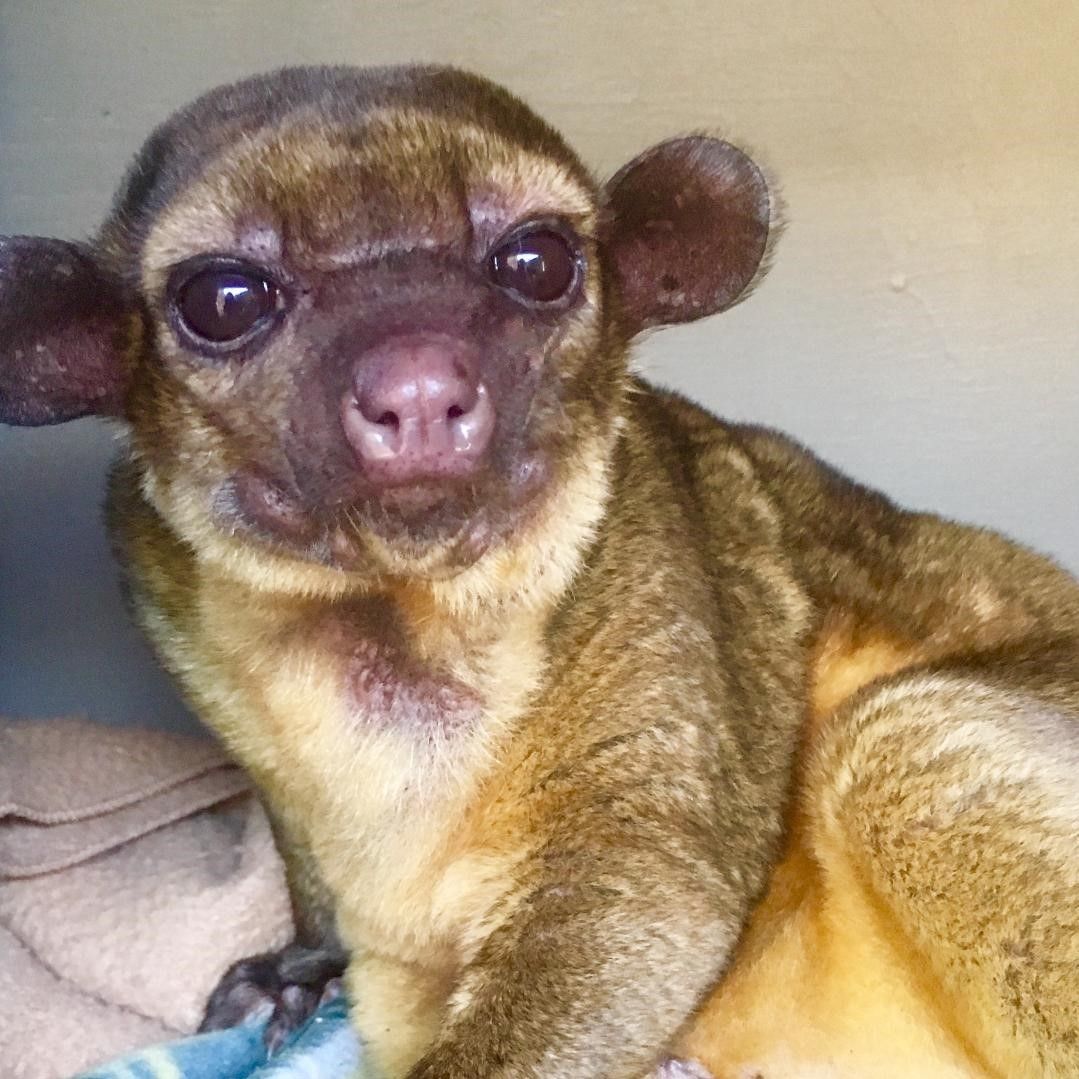Profile | Yoda

-
BirthdayMale, born April 1998
-
SpeciesKinkajou
Potos flavus -
Professor ofPollination and seed dispersal
-
Field of StudyArboreal adaptations
-
Food and Vet Care$309 per month | $3720 each year
About the species
RANGE | Kinkajous live in rainforests, ranging from east and south of the Sierra Madres in Mexico, throughout Central America to Bolivia east of the Andes and the Atlantic Forest of southeastern Brazil.
FUN FACTS | Kinkajous are arboreal and possess many adaptations common to other tree-dwelling species, including small and bare hands with sharp claws and a long, fully prehensile tail. They use their tails to hold onto branches and to balance when they’re moving in the treetops. They can grasp the branches with their tail and release their paws to get access to foods otherwise beyond their reach. Like other animals in the raccoon family, they have fully reversible hind feet so they can quickly navigate down trees headfirst to watch for predators- including raptors, foxes, small felines and people.
They have thick wooly fur that consists of a golden outer coat and a grey undercoat to help keep them dry as well as protect them from bees when raiding a hive in the night, earning them the name of honey bear. They have a 6 inch long tongue which makes it possible to easily obtain honey from hives, take insects from their nests and extract nectar from flowers so they act as pollinators. These nocturnal creatures will forage on their own during the night but sometimes in small family groups, with whom they sleep during the day. To allow them to find food and avoid predators, their eyes are highly reflective of light, giving them a bright orange eyeshine as they navigate through the understory and canopy of the rainforest. They are omnivores- eating insects, eggs, hatchlings and small vertebrates as well as leaves, flowers, nuts and other plant material - but nearly 90% of their diet is comprised of fruit.
Meet Yoda
Yoda’s mother was taken from the rainforest and smuggled into the US, illegally, to be kept as a pet. Once she was in the US, the people set up a cage in their backyard and thought everything would be fine. However, she wasn’t eating any of the food they offered, and she would bite and snarl whenever they tried to touch her. Then, after a few days of not eating and becoming increasingly lethargic, they brought her to a local veterinarian. When a closer examination revealed that she was about to have a baby, the vet realized that these people had not only kept an illegal pet, they had poached and smuggled a pregnant female away from her home in the jungle. So, Yoda was born at that veterinarian's office and once he was a bit older, his mom went to live at a zoo and he was placed with us.
While many of our nocturnal animals become much more active in the daytime due to all of the activity around them, Yoda has remained true to his biological clock. We see him when he pokes his head out to supervise while we clean, but he otherwise sleeps all day. We can tell he is VERY busy all night long, by the mess he leaves for us in the morning! He explores every inch of his enclosure, climbing, playing and moving things around. If we come in early or return late from a program, he is like a little gremlin after a drink of water! He whistles and vocalizes to us, calling us in to play...and who can refuse that adorable face?
Yoda has been with us for over 20 years now, and remains in good health overall. He continues to enjoy doing programs and, as long as he seems healthy and happy, will continue to do so.
Likes
Yoda loves toys that have multiple shapes- beads, blocks or similar items- that move so toddler toys and puzzle feeders are always enjoyed. He enjoys stuffed animals but they need to be heavy duty to withstand his sharp claws and teeth. Puzzle feeders and play structures give him new ways to utilize his space, providing new textures and challenges. Yoda really seems to enjoy baby and toddler toys that are designed to encourage children to develop their ability to manipulate objects with their hands with items that dangle and move are especially interesting as are toddler toys that move or make a sound. He loves when we modify his enclosure by adding things at different levels- swinging and hanging items, shelved and other items that can act as platforms and challenging ways to access treats. He also loves cat beds and warm, fuzzy fleece blankets.
Wishlist
-
Beddingfleece blankets and fuzzy dog beds, as well as a heating pad made for outdoor use by animals
-
Heavy duty dog toysby Kong, Vitscan, Hugglehounds, Ho-lee Roller balls, goDog, oneisall, JollyPets, Dogzilla eggs, different shapes/sizes of BoomerBalls, LPHNSUR ToughDogChews, or others made for chewers
-
Natural Woodfresh cut, non-sprayed branches from maple, oak, willow, birch, pear, or apple trees
-
Play structurestoddler play structures, playhouses, picnic tables, and workbenches
-
Puzzle feedersdesigned for dogs
-
Travel carriersone for each animal, to leave in enclosure for evac training